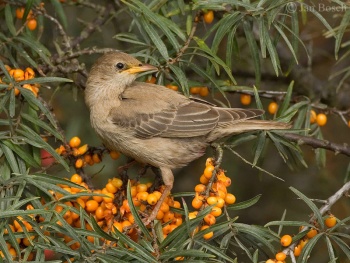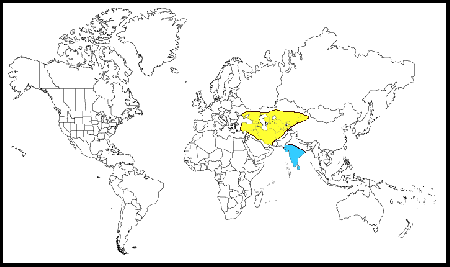Alternarive names: Rose-coloured Starling, Rosy Pastor
- Pastor roseus
Sturnus roseus
Identification

Photo © by jandok
Lauwersmeer, Netherlands
21cm (8¼ in). A medium-sized Starling.
- Rose-pink body with glossy black crested head, neck, wings, vent and tail
- Pink legs
- Orange/pink short and stout bill in summer, brown in winter
- Pink parts sullied grey in winter
Sexes similar, females are a bit duller and have a shorter crest.
Juveniles don't have a crest. They have sandy-brown upperparts, dark, pale-fringed wings, a dark tail and whitish underparts.
Their bill is yellowish. The pale rump and the dark patches under the wing show in flight.
Similar Species
Juvenile resembles a pale young Common Starling, but can be identified by the pink legs and paler plumage.
Distribution
| Breeds regularly from southern Ukraine east over the central Asian steppes to Kazakhstan, Western Mongolia and south to eastern Turkey, Iran, Afghanistan and northwest China. Occasionally further west to Eastern Europe and as a vagrant in western Europe. Most birds winter in India and Sri Lanka. | |
| Legend • S. roseus; breeding range |

Photo © by Alok Tewari
Gurgaon Rural, Haryana, India, July-2018
Taxonomy
This is a monotypic species[1], which is sometimes placed in the genus Sturnus.
Habitat
Steppe and open agricultural land.
Behaviour
Gregarious, forming flocks with Common Starling.
Breeding
Nests in holes in walls, among stones on open ground. Breeds colonial, some colonies with thousands of birds.
Diet
Its diet includes grasshoppers and other insects.
Vocalisation
High-pitched rapid chatter when feeding in flocks.
References
- Clements, J. F., T. S. Schulenberg, M. J. Iliff, D. Roberson, T. A. Fredericks, B. L. Sullivan, and C. L. Wood. 2017. The eBird/Clements checklist of birds of the world: v2017, with updates to August 2017. Downloaded from http://www.birds.cornell.edu/clementschecklist/download/
- Del Hoyo, J, A Elliott, and D Christie, eds. 2009. Handbook of the Birds of the World. Volume 14: Bush-shrikes to Old World Sparrows. Barcelona: Lynx Edicions. ISBN 978-8496553507
- Birdwatchers Pocket Guide ISBN 1-85732-804-3
- Collins Pocket Guide to British Birds 1966
- Collins Field Guide 5th Edition
Recommended Citation
- BirdForum Opus contributors. (2024) Rosy Starling. In: BirdForum, the forum for wild birds and birding. Retrieved 19 April 2024 from https://www.birdforum.net/opus/Rosy_Starling
External Links
Search the Gallery using the scientific name:
GSearch checked for 2020 platform.






